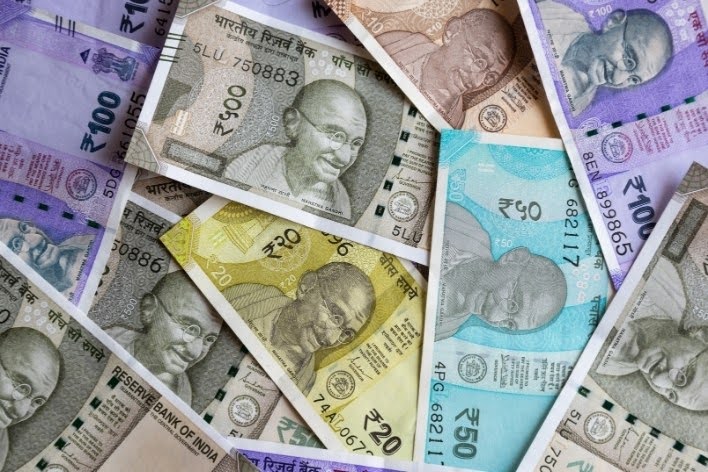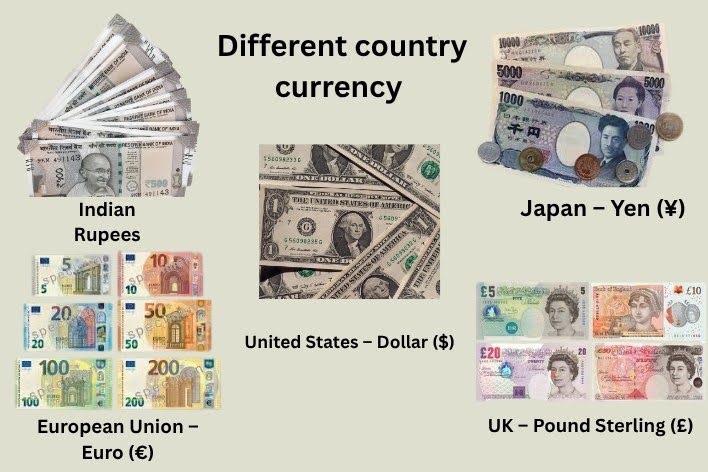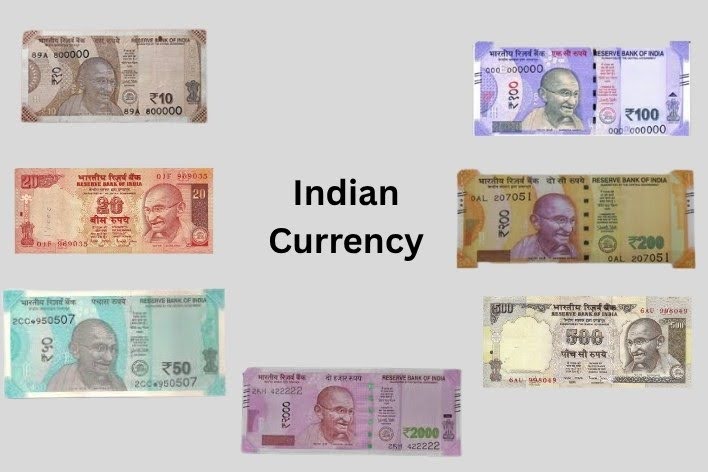Currency Notes
Have you ever gone shopping with your mother and father and seen them hand over colourful portions of paper to the shopkeeper? These colourful papers aren't simply any paper – they may be currency notes! But what are foreign money notes, and why are they so vital?
In this blog, we’ll examine the entirety of currency notes in a fun and simple manner. From their types to their uses, to how they look in one-of-a-kind international locations, we’ve been given it all covered!
Table of contents
- What Are Currency Notes?
- The History of Currency Notes
- What Are Country Currency Notes?
- What Are Different Currency Notes?
- Different Currency Notes with Names and Designs
- Types of Currency Notes in India
- Why Currency Notes Are Important
- How to Identify Real Currency Notes
- Who Makes Currency Notes?
- How to Take Care of Your Currency Notes
- What Happens When Old Notes Are Replaced?
What Are Currency Notes?

Currency notes are unique pieces of paper issued by using a country’s government or relevant bank that human beings use to buy goods and offerings. Before forex notes were invented, human beings used the barter gadget. That approach, if a person had wheat and needed rice, they had to locate a person who had rice and wanted wheat. This becomes hard and time-eating.
To make existence simpler, people invented foreign money notes. Now, rather than replacing goods, we use cash. This cash may be in the form of coins or forex notes. The notes are simpler to hold, count, and use in each day's existence.
The History of Currency Notes
The first paper money changed into utilized in China over 1,000 years ago! They needed something lighter than metal cash to carry around. Slowly, the concept of forex notes spread to different international locations. Today, every country uses its own version of currency notes, known as country currency notes.
Each country designs its own currency notes, making them precise with national symbols, well-known leaders, ancient sites, or neighborhood animals and plant life. These special designs help human beings feel pleased with their country and also prevent faux notes.
What Are Country Currency Notes?
Country currency notes are duly issued by and assigned to a particular country. In India, we talk about the Indian Rupee (₹), so our country currency notes will be ₹10, ₹20, ₹50, and so on.
Thus every country has a currency and currency notes. Currency notes are called differently because of the different names, patterns, and values attached to them from one country to another.
Let us now look at five names of the types of currencies used in different parts of the world:
- India – Rupee (₹)
- United States – Dollar ($)
- Japan – Yen (¥)
- United Kingdom – Pound Sterling (£)
- European Union – Euro (€)

These are a number of the most commonplace country forex notes used across the world.
What Are Different Currency Notes?
When we say extraordinary currency notes, we suggest that every u . S . Has many notes of various values. For example, India has ₹10, ₹20, ₹50, ₹one hundred, ₹200, ₹500, and ₹2000 notes. These are all varieties of foreign money notes we use in regular existence.
Similarly, the United States has $1, $5, $10, $20, $50, and $100 notes. All of those are distinct foreign money notes in the US device.
Each of those notes is beneficial for purchasing extraordinary objects. A ₹10 notice would possibly help you purchase a snack, at the same time as a ₹500 note can assist you to buy groceries for your circle of relatives.
Different Currency Notes with Names and Designs
Each currency note in India and in other international locations has its very own name and design. These special currency notes with names display pics that tell us something about the United States of america.
Let’s explore distinctive forex notes with names in India:
- ₹10: Light brown, regularly functions Indian flora and fauna like elephants or historical past temples.
- ₹20: Bright orange, now and again indicates Indian structure like the Ellora caves.
- ₹50: Purple, features Mahatma Gandhi and Indian cultural symbols.
- ₹100: Blue, highlights India’s beautiful herbal places.
- ₹200: Yellow, clean to identify, used in medium-sized purchases.
- ₹500: Greenish-gray, very not unusual in ordinary use.
- ₹2000: Magenta, used for huge expenses (but much less commonplace now).

These are simply examples of sorts of currency notes that help us in coping with one-of-a-kind quantities of cash effortlessly.
Types of Currency Notes in India
India has many types of currency notes, each useful in distinctive conditions. Here’s a more in-depth study these types of currency notes and when you would possibly use them:
- ₹10 and ₹20: Used for small purchases like snacks or stationery.
- ₹50 and ₹100: Handy for purchasing school elements or taking place on quick journeys.
- ₹200 and ₹500: Useful for grocery shopping or paying bills.
- ₹2000: Often used for big bills, though no longer seen regularly anymore.
These styles of currency notes are revealed by the Reserve Bank of India (RBI), that's the best authority allowed to print forex notes within the US.
Why Currency Notes Are Important?
Currency notes help us stay extra prepared and comfortable. Here are a few reasons why currency notes are so vital:
Easy to use – Lightweight and clean to carry.
Quick to count – We can effortlessly add up the cost of different foreign money notes.
Help in trade – People can buy and sell matters quickly using cash.
Store value – You can store foreign money notes in a financial institution or a piggy financial institution.
Accepted with the aid of all – Whether you’re at a small keep or a massive mall, currency notes are typical anywhere.
How to Take Care of Your Currency Notes
Taking care of your currency notes could be very vital. Here’s the way to do it:
-
Do not write or draw on the notes.
-
Keep them flat in pockets or ebooks.
-
Don’t fold or tear them.
-
Keep them away from water and dust.
-
If you recognize your currency notes, they will close longer and serve their purpose better!
What Happens When Old Notes Are Replaced?
Sometimes, old forex notes are taken out of use and new ones are added. This is referred to as demonetization. In India, it fell in 2016 when vintage ₹500 and ₹one thousand notes were stopped, and new ₹500 and ₹2000 notes were introduced.
This allows the fight towards fake money and continues our money gadget safe. Countries do that once they want to improve the design or add protection capabilities to their U. S . A . Foreign money notes.
More Country Currency Notes Around the World
Let’s analyze extra approximately distinctive currency notes with names used globally:
- 🇨🇳 China – Yuan (¥)
Chinese notes have leaders and historic symbols. Their currency notes are colorful and certain. - 🇧🇷 Brazil – Real (R$)
Brazilian foreign money notes regularly have animals and vibrant designs. - 🇸🇬 Singapore – Dollar (S$)
These United States forex notes are crafted from plastic and are very long lasting. - 🇸🇪 Sweden – Krona (kr)
Swedish notes consist of scientists, artists, and historic figures.
All these extraordinary currency notes help their international locations exchange and grow their economic system.
How to Identify Real Currency Notes
There are many fake notes inside the international, so it’s important to learn how to check in case your foreign money notes are actual. Here’s how:
- Watermark – Hold the be aware of the light. You’ll see a hidden image like Mahatma Gandhi.
- Security Thread – A shiny line runs from top to bottom.
- Color Change Ink – Some numbers exchange color while you tilt to be aware.
- Raised Printing – Feel the surface for rough textual content and numbers.
- Micro Letters – Very small letters you could best see intently.
These features are observed in all Indian kinds of forex notes and help us live safely from fake ones.
Real-Life Examples of Currency Notes
Let’s examine some real-life examples to see how we use forex notes each day.
1. Buying Ice Cream
Riya goes to an ice cream store. The ice cream charges ₹30. She gives the shopkeeper a ₹50 notice. He gives her ₹20 returned as change. This indicates how currency notes assist in normal transactions.
2. Birthday Gift
Rahul’s uncle offers him ₹500 for his birthday. Rahul makes use of ₹two hundred to buy a toy and saves ₹300. He learns the way to spend wisely and keep for destiny.
3. School Trip
For a faculty experience, each student has to deliver ₹250. Aarav gives two ₹ hundred notes and one ₹50 notice. The teacher counts the forex notes effortlessly.
4. Pocket Money
Maya gets ₹20 every week from her parents. She collects one-of-a-kind forex notes like ₹10 and ₹50 and saves them in her piggy financial institution. She enjoys seeing her money grow!
These examples help you to understand the role of currency notes in actual lifestyles.
Who Makes Currency Notes?
In India, simply, the Reserve Bank of India (RBI) is authorized to print currency notes. The RBI makes choices about:
-
The size of the notes
-
The design and coloration
-
The symbols and pictures
-
The safety features
In different international locations too, country currency notes are revealed with the aid of vital banks like:
- Federal Reserve (USA)
- Bank of England (UK)
- European Central Bank (EU)
- Bank of Japan (Japan)
Fun Facts About Currency Notes
Here are six cool facts about currency notes that will amaze you:
-
Currency notes aren't made from ordinary paper. They are made of cotton and polymer to last longer!
-
Canada’s forex notes are made from plastic and are waterproof!
-
The ₹2000 observe was brought in 2016 after the demonetization.
-
Australia’s United States currency notes are see-through and wonderfully hard to copy.
-
In a few nations like Japan, notes encompass marks to help blind people pick them out.
-
The smallest forex observer ever made was from Romania and is smaller than a playing card!
Things you have learnt!
-
Learning approximately forex notes allows you:
-
Understand how cash works
-
Make better spending and saving decisions
-
Recognize distinctive values
-
Respect the money you use each day
FAQs
-
Seven Types of Currency Notes in India?
- Notes are issued in denominations of ₹2, ₹5, ₹10, ₹20, ₹50, ₹100, ₹200, ₹500, and ₹2000 in India.
- Among these, ₹2 and ₹5 notes have almost disappeared from the market while ₹2000 is set to be withdrawn.
-
Paper Composition of Currency Notes?
- Indian currency notes are made from a special blend of 100% cotton fibre and cotton rag.
- This makes them highly durable with a distinct feel, which resists wear and tear.
-
First Currency Note in India?
- The first paper currency in India was issued in 1812 by the Bank of Hindostan for ₹10.
- The first currency note issued by the Government of India was also for ₹10, in the year 1861.
-
Father of Indian Currency?
- James Prinsep is regarded as the father of Indian currency.
- He was a scholar and an antiquary who researched Indian coinage and scripts.
Practice Questions
1) Answer The Following Questions.
- The National Currency Of India Is …………
i) Pound ii) Won
iii)Taka iv) Rupee - The National Currency Of England Is …………
i) Pound ii) Won
iii)Taka iv) Rupee - The National Currency Of Brazil Is …………
i) Brazilian real ii) Taka
iii) Pound iv) Peso - The National Currency Of Bangladesh Is …………
i) Rupee ii) Ruble
iii) Brazilian real iv) Taka - The National Currency Of Italy Is …………
i) Taka ii) Euro
iii) Ruble iv) Won
The complete answer is given below:
- The National Currency Of India Is Rupee
i) Pound ii) Won
iii)Taka iv) Rupee - The National Currency Of England Is Pound
i) Pound ii) Won
iii)Taka iv) Rupee - The National Currency Of Brazil Is Brazilian real
i) Brazilian real ii) Taka
iii) Pound iv) Peso - The National Currency Of Bangladesh Is Taka
i) Rupee ii) Ruble
iii) Brazilian real iv) - The National Currency Of Italy Is Euro
i) Taka ii) Euro
iii) Ruble iv) Won
2) Search The Currencies Of The Following Countries And Write Their Name And Symbol. The First One Is A Solved Example.
Example = India = Indian rupee = ₹
- United Kingdom = ………… = …………
- China = ………… = …………
- Germany = ………… = …………
- Jersey = ………… = …………
- Nepal = ………… = …………
- US = ………… = …………
- Indonesia = ………… = …………
- Italy = ………… = …………
- Russia = ………… = …………
- Australia = ………… = …………
Search the currencies of the following countries and write their name and symbol. The first one is a solved example.
Example = India = Indian rupee = ₹
- United Kingdom = Pound sterling = £
- China = Yuan = ¥
- Germany = Euro = €
- Jersey = Pound = £
- Nepal = Rupee = Rs.
- US = US Dollar = $
- Indonesia = Rupiah = Rp
- Italy = Euro = €
- Russia = Ruble = ₽
- Australia = Dollar = $
3) Match The Following.

The correct match is shown below:

CBSE Schools In Popular Cities
- CBSE Schools in Bangalore
- CBSE Schools in Mumbai
- CBSE Schools in Pune
- CBSE Schools in Hyderabad
- CBSE Schools in Chennai
- CBSE Schools in Gurgaon
- CBSE Schools in Kolkata
- CBSE Schools in Indore
- CBSE Schools in Sonipat
- CBSE Schools in Delhi
- CBSE Schools in Rohtak
- CBSE Schools in Bhopal
- CBSE Schools in Aurangabad
- CBSE Schools in Jabalpur
- CBSE Schools in Jaipur
- CBSE Schools in Jodhpur
- CBSE Schools in Nagpur
- CBSE Schools in Ahmednagar
- CBSE School In Tumkur











